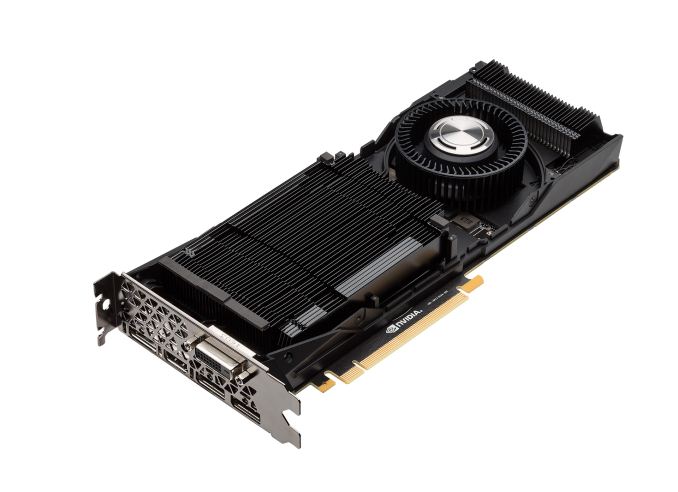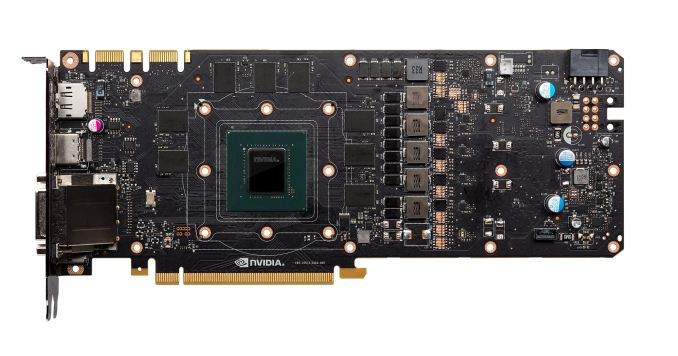The NVIDIA GeForce GTX 1070 Ti Founders Edition Review: GP104 Comes in Threes
by Nate Oh on November 2, 2017 9:00 AM EST- Posted in
- GPUs
- GeForce
- NVIDIA
- Pascal
- GTX 1070 Ti
Meet the GeForce GTX 1070 Ti Founders Edition
For the GeForce GTX 1070 Ti Founders Edition, pinned at the official MSRP of $449, NVIDIA has essentially plopped the GTX 1070 Ti GPU into a GTX 1080 board. This makes a lot of sense considering that this late-cycle card has the same GPU and 180W TDP requirements of NVIDIA's GeForce GTX 1080. Doing so allows NVIDIA to drop in the new specification and go with minimal changes, and similarly, their partners can take their own GTX 1080 designs and quickly reconfigure them for the GTX 1070 Ti.
The end result of this decision is that the GTX 1070 Founders Edition has the same power delivery and cooling specificaitons as the GTX 1080. Which is to say that it retains the same vapor chamber + blower cooling design, and the same 5+1 dual-FET power design. Similarly, that means the GTX 1070 Ti also has the same 120% power limit, and so extending the TDP to 216W. Otherwise, the PCB is exactly the same as the GTX 1080.
It is notable that the GTX 1070 Ti Founders Edition gets the vapor chamber cooler, as the card does not carry a price premium like the other Founders Edition cards do; NVIDIA is not charging more than their partners here. As a high efficiency cooling solution, the vapor chamber works well with the GTX 1070 Ti's increased (relative to the GTX 1070's) 180W TDP and 120% power limit. And while the blower fan is not the quietest, the Founders Edition is able to boost well past its paper-specified clockspeeds.
As we weren't provided with the GTX 1070 Ti PCB photos, we are using the GTX 1080 PCB with GDDR5X modules as an example. As with previous NVIDIA reference PCBs, the 5 GPU power phase and 1 GDDR5 phase is fine for stock operation and mild overclocking, rather than catering to the needs of hardcore overclockers. While not a major point, the Founders Edition isn't really apt to be pushed as a real "overclocking" card; it will boost a little higher but the user experience won't be significantly affected.
Finally, given the identical-to-1080 board design, the rest of the specifications should not come as a surprise. The 10.5" card requires a single PCIe 8-pin power connector for additional power, which combined with the 75W of the PCIe slot, gives the complete card more than enough power for its 180W TDP. Meanwhile on the display side of matters, the GTX 1070 Ti has 3x DisplayPort 1.4, an HDMI 2.0b port, and 1 DL-DVI-D port. The GTX 1070 Ti does support SLI, like all Pascal cards from the GTX 1070 and up.












78 Comments
View All Comments
Morawka - Thursday, November 2, 2017 - link
Nvidia has a ton of flawless GP104 dies stockpiled and the 1080's are selling because they use GDDR5X memory which is slower for mining. This makes perfect sense if what i describe is true. You get rid of all those extra GP104 dies by paring it with lower latency GDDR5. This card was built with miners in mind, particularly with the GDDR5 implementation. .Morawka - Thursday, November 2, 2017 - link
**Miners are not buying gtx 1080 due to slower GDDR5X. Nvidia re-engineers 1080 for better mining performance.CiccioB - Friday, November 3, 2017 - link
Your logic is somehow faulty.The chip mounted on this 1070Ti is far for allowing them to recycle any stockpile of defective chips: it requires the chip to be fully functional but a single SM (5% of the chip).
nvidia could sell much more faulty chips with the original 1070 card at whatever price seen the miners do ask for them as if they were slices of bread.
What nvidia is doing here is just creating a card that on benchmarks runs better than the concurrent card using slightly faulty chips (or disabling them on purpose), selling the card at higher price than the 1070 and just a little below the 1080.
If nvidia had lots of defective GP104 to get rid they could just have created a 1060Ti. But that would be a useless card that would compete with none but 1070, that is they would lose money by doing do.
Kevin G - Thursday, November 2, 2017 - link
AMD has had a long road to get everything integrated together but things finally seem to be falling into place with a common on-die fabric. Their previous SoC designs still had a proprietary bus for the on-die GPU. Infinity fabric is also being pushed to the GPU team for scaling up their designs as well. Long term, I would predict some GPUs falling into the same sockets as their processors for HPC workloads. This long term idea probably won't happen until they use multiple GPU dies on a single interposer.AMD had to do all this work while the company was in in the red but it looks like the results are paying off with a competitive CPU architecture again and some gains on the GPU side too. They're back in the black but I don't think AMD can afford to allocate the resources to a pure enterprise compute project. They won't ignore that market, but the base architecture will stem from the gaming side.
cwolf78 - Thursday, November 2, 2017 - link
I agree it's too expensive as well. I think this should have been set at $399. The sad part is that it's going to be impossible to find at even the MSRP in short order. I'm content to stick with my overclocked GTX 970 until this mining fad is over - or until the current crypto formats become resistant to GPU-based mining.extide - Thursday, November 2, 2017 - link
Honestly, I see nvidia phasing out the vanilla 1070 over the next few months and then sliding the 1070 Ti into the $399 price slot.CiccioB - Thursday, November 2, 2017 - link
This means nvidia is not going to sell GP104 with more than a single SM broken... which is a great waste of money for them. So no, they will keep the old card in stock and this Ti version, in fact, will be rarely found, as it is created just for looking better on charts against a no available card from the concurrent. So it does not need to be produced in mass (and probably cutting that single SM on purpose on a perfectly good die, as I do not think that the availability of GP104 with 1 bad SM can be higher that with 5 bad SM).zepi - Thursday, November 2, 2017 - link
Such chips could still be used sa GTX1070M, so there is still a product where they can be used.Not to mention that at this point of the GP104 manufacturing they should be having very nice yields already.
DanNeely - Thursday, November 2, 2017 - link
There's also the Quadro P4000 which at 14 SM enabled is the lowest end GP104 part on the market.But yeah the 1070 TI only having a single disabled SM almost certainly speaks to much higher yields since the product first launched a year and a half ago.
znd125 - Thursday, November 2, 2017 - link
Great writing and review.